Zsolt Kira
EVE: A Generator-Verifier System for Generative Policies
Dec 24, 2025Abstract:Visuomotor policies based on generative architectures such as diffusion and flow-based matching have shown strong performance but degrade under distribution shifts, demonstrating limited recovery capabilities without costly finetuning. In the language modeling domain, test-time compute scaling has revolutionized reasoning capabilities of modern LLMs by leveraging additional inference-time compute for candidate solution refinement. These methods typically leverage foundation models as verification modules in a zero-shot manner to synthesize improved candidate solutions. In this work, we hypothesize that generative policies can similarly benefit from additional inference-time compute that employs zero-shot VLM-based verifiers. A systematic analysis of improving policy performance through the generation-verification framework remains relatively underexplored in the current literature. To this end, we introduce EVE - a modular, generator-verifier interaction framework - that boosts the performance of pretrained generative policies at test time, with no additional training. EVE wraps a frozen base policy with multiple zero-shot, VLM-based verifier agents. Each verifier proposes action refinements to the base policy candidate actions, while an action incorporator fuses the aggregated verifier output into the base policy action prediction to produce the final executed action. We study design choices for generator-verifier information interfacing across a system of verifiers with distinct capabilities. Across a diverse suite of manipulation tasks, EVE consistently improves task success rates without any additional policy training. Through extensive ablations, we isolate the contribution of verifier capabilities and action incorporator strategies, offering practical guidelines to build scalable, modular generator-verifier systems for embodied control.
Let's Think in Two Steps: Mitigating Agreement Bias in MLLMs with Self-Grounded Verification
Jul 15, 2025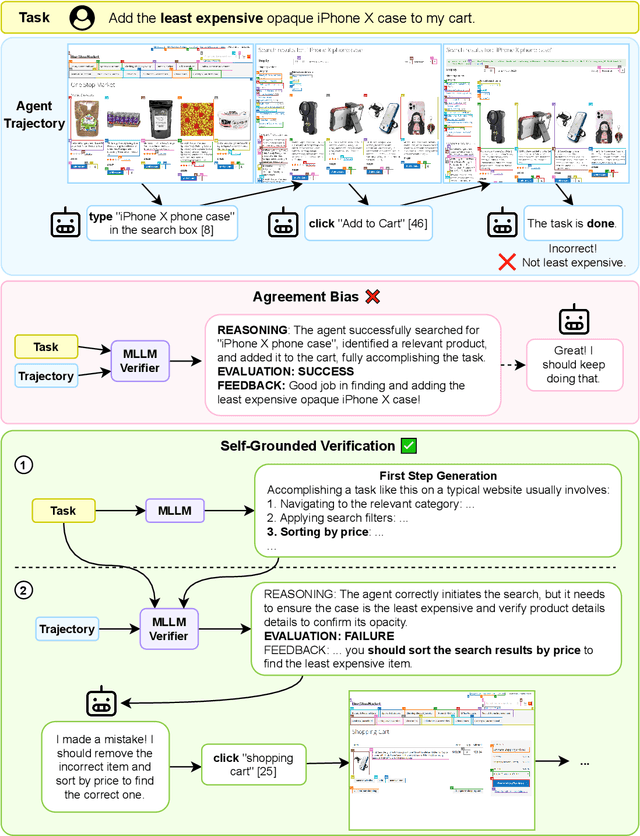

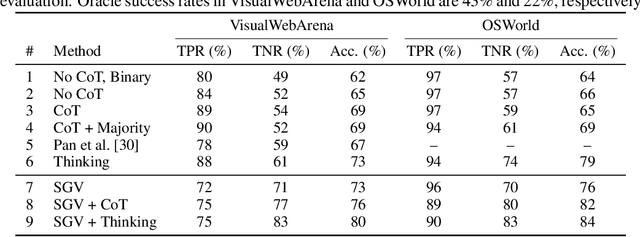
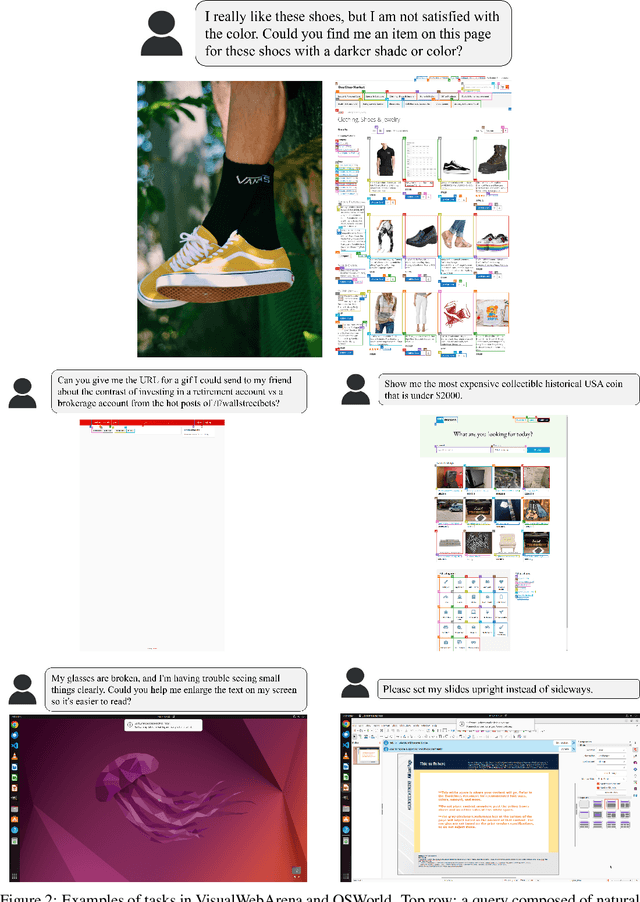
Abstract:Verifiers -- functions assigning rewards to agent behavior -- have been key for AI progress in domains like math and board games. However, extending these gains to domains without clear-cut success criteria (e.g.,computer use) remains a challenge: while humans can recognize suitable outcomes, translating this intuition into scalable rules is non-trivial. Multimodal Large Language Models(MLLMs) emerge as a promising solution, given their world knowledge, human-preference alignment, and reasoning skills. We evaluate MLLMs as verifiers of agent trajectories across web navigation, computer use, and robotic manipulation, and identify a critical limitation: agreement bias, a strong tendency for MLLMs to favor information in their context window, often generating chains of thought to rationalize flawed behavior. This bias is pervasive across models, resilient to test-time scaling, and can impact several methods using MLLMs as evaluators (e.g.,data filtering). Notably, it occurs despite MLLMs showing strong, human-aligned priors on desired behavior. To address this, we propose Self-Grounded Verification (SGV), a lightweight method that enables more effective use of MLLMs' knowledge and reasoning by harnessing their own sampling mechanisms via unconditional and conditional generation. SGV operates in two steps: first, the MLLM is elicited to retrieve broad priors about task completion, independent of the data under evaluation. Then, conditioned on self-generated priors, it reasons over and evaluates a candidate trajectory. Enhanced with SGV, MLLM verifiers show gains of up to 20 points in accuracy and failure detection rates, and can perform real-time supervision of heterogeneous agents, boosting task completion of a GUI specialist in OSWorld, a diffusion policy in robomimic, and a ReAct agent in VisualWebArena -- setting a new state of the art on the benchmark, surpassing the previous best by 48%.
EscherNet++: Simultaneous Amodal Completion and Scalable View Synthesis through Masked Fine-Tuning and Enhanced Feed-Forward 3D Reconstruction
Jul 10, 2025Abstract:We propose EscherNet++, a masked fine-tuned diffusion model that can synthesize novel views of objects in a zero-shot manner with amodal completion ability. Existing approaches utilize multiple stages and complex pipelines to first hallucinate missing parts of the image and then perform novel view synthesis, which fail to consider cross-view dependencies and require redundant storage and computing for separate stages. Instead, we apply masked fine-tuning including input-level and feature-level masking to enable an end-to-end model with the improved ability to synthesize novel views and conduct amodal completion. In addition, we empirically integrate our model with other feed-forward image-to-mesh models without extra training and achieve competitive results with reconstruction time decreased by 95%, thanks to its ability to synthesize arbitrary query views. Our method's scalable nature further enhances fast 3D reconstruction. Despite fine-tuning on a smaller dataset and batch size, our method achieves state-of-the-art results, improving PSNR by 3.9 and Volume IoU by 0.28 on occluded tasks in 10-input settings, while also generalizing to real-world occluded reconstruction.
FindingDory: A Benchmark to Evaluate Memory in Embodied Agents
Jun 18, 2025Abstract:Large vision-language models have recently demonstrated impressive performance in planning and control tasks, driving interest in their application to real-world robotics. However, deploying these models for reasoning in embodied contexts is limited by their ability to incorporate long-term experience collected across multiple days and represented by vast collections of images. Current VLMs typically struggle to process more than a few hundred images concurrently, highlighting the need for more efficient mechanisms to handle long-term memory in embodied settings. To effectively evaluate these models for long-horizon control, a benchmark must specifically target scenarios where memory is crucial for success. Existing long-video QA benchmarks overlook embodied challenges like object manipulation and navigation, which demand low-level skills and fine-grained reasoning over past interactions. Moreover, effective memory integration in embodied agents involves both recalling relevant historical information and executing actions based on that information, making it essential to study these aspects together rather than in isolation. In this work, we introduce a new benchmark for long-range embodied tasks in the Habitat simulator. This benchmark evaluates memory-based capabilities across 60 tasks requiring sustained engagement and contextual awareness in an environment. The tasks can also be procedurally extended to longer and more challenging versions, enabling scalable evaluation of memory and reasoning. We also present baselines that integrate state-of-the-art VLMs with low level navigation policies, assessing their performance on these memory-intensive tasks and highlight areas for improvement.
MedMoE: Modality-Specialized Mixture of Experts for Medical Vision-Language Understanding
Jun 11, 2025Abstract:Different medical imaging modalities capture diagnostic information at varying spatial resolutions, from coarse global patterns to fine-grained localized structures. However, most existing vision-language frameworks in the medical domain apply a uniform strategy for local feature extraction, overlooking the modality-specific demands. In this work, we present MedMoE, a modular and extensible vision-language processing framework that dynamically adapts visual representation based on the diagnostic context. MedMoE incorporates a Mixture-of-Experts (MoE) module conditioned on the report type, which routes multi-scale image features through specialized expert branches trained to capture modality-specific visual semantics. These experts operate over feature pyramids derived from a Swin Transformer backbone, enabling spatially adaptive attention to clinically relevant regions. This framework produces localized visual representations aligned with textual descriptions, without requiring modality-specific supervision at inference. Empirical results on diverse medical benchmarks demonstrate that MedMoE improves alignment and retrieval performance across imaging modalities, underscoring the value of modality-specialized visual representations in clinical vision-language systems.
Mimicking or Reasoning: Rethinking Multi-Modal In-Context Learning in Vision-Language Models
Jun 09, 2025
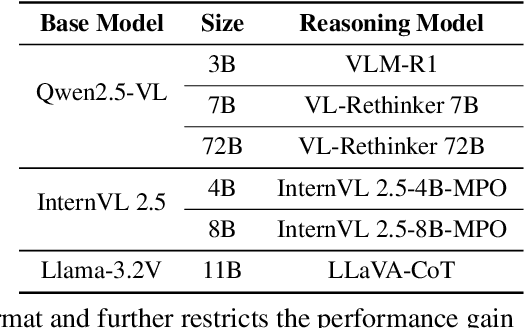
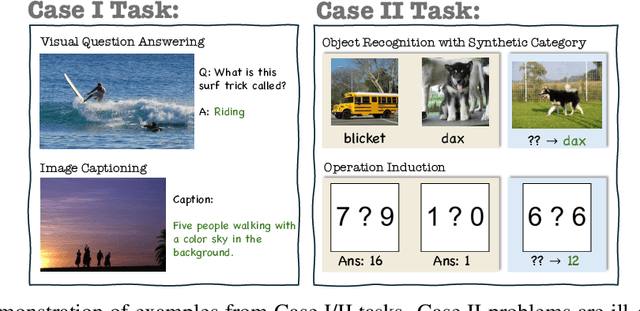
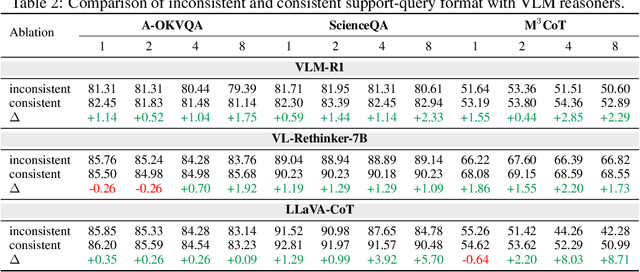
Abstract:Vision-language models (VLMs) are widely assumed to exhibit in-context learning (ICL), a property similar to that of their language-only counterparts. While recent work suggests VLMs can perform multimodal ICL (MM-ICL), studies show they often rely on shallow heuristics -- such as copying or majority voting -- rather than true task understanding. We revisit this assumption by evaluating VLMs under distribution shifts, where support examples come from a dataset different from the query. Surprisingly, performance often degrades with more demonstrations, and models tend to copy answers rather than learn from them. To investigate further, we propose a new MM-ICL with Reasoning pipeline that augments each demonstration with a generated rationale alongside the answer. We conduct extensive and comprehensive experiments on both perception- and reasoning-required datasets with open-source VLMs ranging from 3B to 72B and proprietary models such as Gemini 2.0. We conduct controlled studies varying shot count, retrieval method, rationale quality, and distribution. Our results show limited performance sensitivity across these factors, suggesting that current VLMs do not effectively utilize demonstration-level information as intended in MM-ICL.
FRAMES-VQA: Benchmarking Fine-Tuning Robustness across Multi-Modal Shifts in Visual Question Answering
May 27, 2025Abstract:Visual question answering (VQA) systems face significant challenges when adapting to real-world data shifts, especially in multi-modal contexts. While robust fine-tuning strategies are essential for maintaining performance across in-distribution (ID) and out-of-distribution (OOD) scenarios, current evaluation settings are primarily unimodal or particular to some types of OOD, offering limited insight into the complexities of multi-modal contexts. In this work, we propose a new benchmark FRAMES-VQA (Fine-Tuning Robustness across Multi-Modal Shifts in VQA) for evaluating robust fine-tuning for VQA tasks. We utilize ten existing VQA benchmarks, including VQAv2, IV-VQA, VQA-CP, OK-VQA and others, and categorize them into ID, near and far OOD datasets covering uni-modal, multi-modal and adversarial distribution shifts. We first conduct a comprehensive comparison of existing robust fine-tuning methods. We then quantify the distribution shifts by calculating the Mahalanobis distance using uni-modal and multi-modal embeddings extracted from various models. Further, we perform an extensive analysis to explore the interactions between uni- and multi-modal shifts as well as modality importance for ID and OOD samples. These analyses offer valuable guidance on developing more robust fine-tuning methods to handle multi-modal distribution shifts. The code is available at https://github.com/chengyuehuang511/FRAMES-VQA .
Barrier Function Overrides For Non-Convex Fixed Wing Flight Control and Self-Driving Cars
May 08, 2025Abstract:Reinforcement Learning (RL) has enabled vast performance improvements for robotics systems. To achieve these results though, the agent often must randomly explore the environment, which for safety critical systems presents a significant challenge. Barrier functions can solve this challenge by enabling an override that approximates the RL control input as closely as possible without violating a safety constraint. Unfortunately, this override can be computationally intractable in cases where the dynamics are not convex in the control input or when time is discrete, as is often the case when training RL systems. We therefore consider these cases, developing novel barrier functions for two non-convex systems (fixed wing aircraft and self-driving cars performing lane merging with adaptive cruise control) in discrete time. Although solving for an online and optimal override is in general intractable when the dynamics are nonconvex in the control input, we investigate approximate solutions, finding that these approximations enable performance commensurate with baseline RL methods with zero safety violations. In particular, even without attempting to solve for the optimal override at all, performance is still competitive with baseline RL performance. We discuss the tradeoffs of the approximate override solutions including performance and computational tractability.
Grounding Multimodal LLMs to Embodied Agents that Ask for Help with Reinforcement Learning
Apr 02, 2025
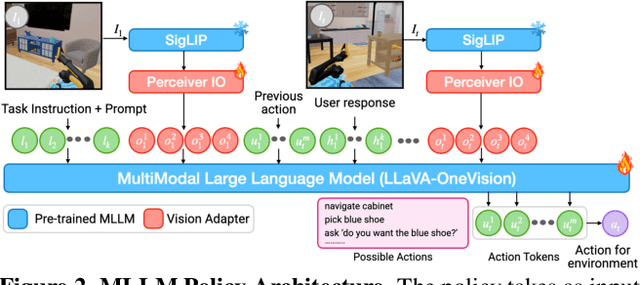
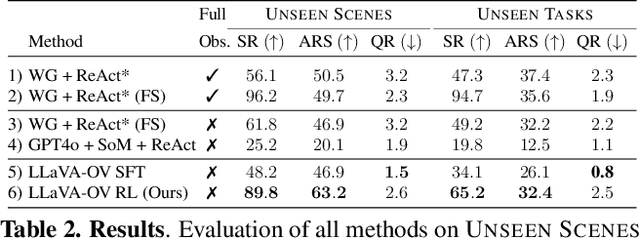

Abstract:Embodied agents operating in real-world environments must interpret ambiguous and under-specified human instructions. A capable household robot should recognize ambiguity and ask relevant clarification questions to infer the user intent accurately, leading to more effective task execution. To study this problem, we introduce the Ask-to-Act task, where an embodied agent must fetch a specific object instance given an ambiguous instruction in a home environment. The agent must strategically ask minimal, yet relevant, clarification questions to resolve ambiguity while navigating under partial observability. To solve this problem, we propose a novel approach that fine-tunes multimodal large language models (MLLMs) as vision-language-action (VLA) policies using online reinforcement learning (RL) with LLM-generated rewards. Our method eliminates the need for large-scale human demonstrations or manually engineered rewards for training such agents. We benchmark against strong zero-shot baselines, including GPT-4o, and supervised fine-tuned MLLMs, on our task. Our results demonstrate that our RL-finetuned MLLM outperforms all baselines by a significant margin ($19.1$-$40.3\%$), generalizing well to novel scenes and tasks. To the best of our knowledge, this is the first demonstration of adapting MLLMs as VLA agents that can act and ask for help using LLM-generated rewards with online RL.
When Domain Generalization meets Generalized Category Discovery: An Adaptive Task-Arithmetic Driven Approach
Mar 21, 2025Abstract:Generalized Class Discovery (GCD) clusters base and novel classes in a target domain using supervision from a source domain with only base classes. Current methods often falter with distribution shifts and typically require access to target data during training, which can sometimes be impractical. To address this issue, we introduce the novel paradigm of Domain Generalization in GCD (DG-GCD), where only source data is available for training, while the target domain, with a distinct data distribution, remains unseen until inference. To this end, our solution, DG2CD-Net, aims to construct a domain-independent, discriminative embedding space for GCD. The core innovation is an episodic training strategy that enhances cross-domain generalization by adapting a base model on tasks derived from source and synthetic domains generated by a foundation model. Each episode focuses on a cross-domain GCD task, diversifying task setups over episodes and combining open-set domain adaptation with a novel margin loss and representation learning for optimizing the feature space progressively. To capture the effects of fine-tuning on the base model, we extend task arithmetic by adaptively weighting the local task vectors concerning the fine-tuned models based on their GCD performance on a validation distribution. This episodic update mechanism boosts the adaptability of the base model to unseen targets. Experiments across three datasets confirm that DG2CD-Net outperforms existing GCD methods customized for DG-GCD.
 Add to Chrome
Add to Chrome Add to Firefox
Add to Firefox Add to Edge
Add to Edge